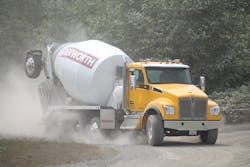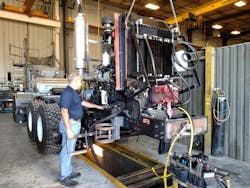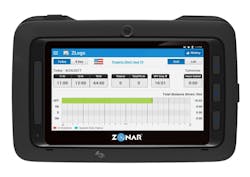Government Rules Push More Changes for Heavy Trucks
Over the years, government laws and regulations have been major influences on truck development and trucking operations. Everything from axle configurations to diesel exhaust emissions to hours of service are defined or limited by government fiat, for better or for worse. And once rules are in place, they seldom go away. But President Donald Trump has promised to repeal onerous regulations put in force by previous administrations. And it’s happening.
In trucking, Trump officials have announced a review of a portion of Phase 2 of the Greenhouse Gas and Fuel Economy rules, released only last year, affecting heavy trailers and glider kits. The object of the lengthy rules, jointly written by the Environmental Protection Agency and the National Highway Traffic Safety Administration, is to reduce emissions of carbon dioxide and other gasses thought to cause climate change. Phase 2 follows previously issued rules now in effect.
Emissions reduction is to be accomplished by cutting the amount of fuel burned—a win for both truck owners and clean-air advocates—and eliminating older, dirty diesels. As it now stands, Phase 2 begins going into effect for trailers in January and rolls out for other vehicles over the next 10 years.
EPA’s mid-August announcement that it would review Phase 2 was brief, and did not explain what might change. It pleased the Truck Trailer Manufacturers Association, which had petitioned against Phase 2. It argued that the rule requires aerodynamic-enhancing equipment, special tires, and tire-pressure-monitoring systems on all box-type trailers, whether or not they would provide cost-effective benefits. The association pointed out that trailers operating at low average speeds and sitting a lot while loading and unloading would gain next to nothing in fuel savings and CO2 reduction. However, as welcome as reconsideration is, it’s also causing great uncertainty, which concerns builders. The deadline for meeting current Phase 2 rules is looming, and they, their suppliers, and their customers need to know soon which way to go.
Under Phase 2, dump, flatbed, and other construction-related trailers will need only tire-pressure systems, according to Ben Sharpe, a principal researcher at the International Council on Clean Transportation, an environmental think tank whose staffers analyzed the 1,800-page document when it was finalized. That’s because the regulators recognized that aero improvers, in particular, are neither practical nor useful for most vocational trailers. Eventually, cutting weight will become more important. How all this might change under a review by the Trump-run EPA is unknown, and the EPA is not commenting.
Reprieve for gliders?
Glider kits—new vehicles powered by used or renewed engines and driveline components—cost much less than a completely new truck, so they are especially popular with users of forward-discharge concrete mixer trucks. However, starting in January 2021, they’ll be allowed only for their original purpose, which was reclaiming powertrains from wrecked trucks. This goes back many years when glider kits were bought as service parts. Though a small percentage of total new truck sales, gliders’ older diesels produce far more exhaust emissions, the EPA contended. The agency became concerned at a surge in sales, from a few hundred per year 10 to 20 years ago to more than 20,000 in 2015. Most of those were highway tractors and were undisguised efforts to avoid modern emissions limits and the expensive engines needed to meet them, the agency said.
Oshkosh, Indiana Phoenix, and Terex Advance make gliders for front-discharge mixers. Terex Advance has said it has built trucks with currently certified diesels combined with used (and usually rebuilt or remanufactured) transmissions and axles. But the dollar savings over an all-new truck were only 10 percent versus 30 percent or more when an older engine is also used.
“We would welcome any revisit or revising by the EPA,” says Jared Widenhoefer, Terex Advance’s marketing manager. “But at the end of the day, we’ll abide by whatever EPA decides.... It could be as simple as [entirely] reinstating gliders, or perhaps use updated EPA engines, maybe a pre-2007,” which would be cleaner than the 1998-2004 engines now commonly used. “I don’t really know,” he says.
Above photo: A rebuilt Cummins ISL diesel is installed in a new front-discharge mixer chassis at Indiana Phoenix.
For 2017, the current EPA rules allow Advance to build a portion of its 2015 production, or under 200 units, and it’s no longer taking orders for gliders, Widenhoefer says. After this year, gliders would have to be powered by new diesels or natural gas engines. And “by the time you add a new engine, the savings are so small that it doesn’t make sense anymore. So after this year, there are no plans for us to produce any gliders. At one time, gliders were a substantial part of our business. So it’s been an adjustment for us and for the whole marketplace.”
Current rules allow small numbers of gliders with older engines to be assembled by builders, dealers and individual truckers until 2021. Fortunately for Advance and others, the mixer business is strong and front-discharge trucks comprise a larger share of that market. And greater fuel economy promised by 2017 and later diesels can offset the higher prices of all-new mixer trucks.
Daimler Trucks North America’s Freightliner arm has built most highway-type glider kits used in the United States; Western Star, another Daimler company, also builds some, as do Paccar’s Kenworth and Peterbilt divisions. Most of them have shied away from commenting because the idea of a truck that pollutes more than it could is sensitive and they’d rather not get tangled in any controversy. Protests by clean-air advocates are likely if EPA backs away from its current rules.
ELD mandate looms
Electronic logging devices, or ELDs, will be required starting on December 18, under a rule promulgated by the Federal Motor Carrier Safety Administration (FMCSA) in 2015. ELDs are not new, and some large freight carriers have used them for years. But most truckers do not, so there’s been angst in the industry. Especially widespread is the fear that drivers’ actual operating hours will be fewer because they no longer will be able to fudge their paper logs—a time (dis)honored practice since log books came into use in the mid-1930s.
The good news is that drivers of trucks that run within 100 air-miles of home base, as many construction trucks do, are exempt from the ELD mandate, though they must meet certain requirements. If they run farther afield and paper-log their hours, they must make the change, but it can be as simple as acquiring an app for a smartphone and plugging it into a truck’s data port. And many ELDs come with an array of functions, from pre-trip inspections to tracking where the truck’s been and how it’s being driven. If used intelligently, these capabilities can boost efficiency and profits.
Automatic on-board recording devices, or AOBRDs, are a different kind of device, but they can capture driver-logging information. So under the regulation, they will suffice for another two years, until Dec. 18, 2019. Another exemption is for trucks older than model-year 2000 because they lack electronic capabilities needed for this type of data gathering.
That 100-air-mile-radius exemption is often misunderstood, says Ryan Wiese, compliance manager at Zonar Systems, a supplier of the electronic equipment. To keep the exemption, a driver must:
- operate out of his/her normal work reporting location,
- start and end the day at the same location,
- be released from work within 12 consecutive hours,
- have at least 10 consecutive hours off-duty between each 12-hour shift, and
- not drive more than 11 hours.
Above photo: Zonar’s Connect electronically duplicate the traditional driver’s paper log.
“If a single requirement is unmet, the driver must complete a log for the day,” Wiese says. “For example, if a driver has a special assignment and ends his or her day at a different reporting location, the exemption does not apply for that day. This is probably the most common mistake made.
“Furthermore, if a driver breaks any above condition more than eight times in a rolling 30-day period, the driver is required to install and use an ELD from that point forward, according to the final ELD rule.” The rule covers more than 500 pages, so he encourages drivers and managers with any questions to contact someone who specializes in such matters.
Even if a locally operating fleet is exempt, managers should consider acquiring ELDs or AOBRDs and using them to gather valuable operating data, according to Dale Dunaitis, a former million-mile driver, safety director at a large fleet, and now at SpeedGauge, and a consultant on speed monitoring, safety, and compliance matters. He says he knows of more than two dozen construction fleets that are using ELDs to gather money-saving operating information, and two-thirds of those are using electronic logging.
“They’re embracing the data in order to give them the competitive edge that they need,” Dunaitis says. “If you don’t have all the information, you can’t be as efficient as you can. Even if you don’t flip on the ELD portion, what you see is amazing. It is absolutely shocking. If you improve driver efficiency, you may not need as many dispatchers. Maintenance issues: You can find them through data long before they result in a breakdown. Maybe the engine ECM wasn’t set up correctly at the dealer, and that will keep the truck and its engine from running most efficiently.
“Instead of looking at the ELD as a hammer, look at it as a lever, and use that lever to make money,” he says. “Companies that fail because of the ELD requirement are going to fail in the office, not because of
the driver.”
For older drivers and fleet owners, learning something new is a challenge. But it’s not a problem for young folks, and Dunaitis suggests hiring one of them to begin managing the new data being acquired. Also, how-to lessons are available from manufacturers and instructional videos are appearing on YouTube. Go there, type “electronic logging devices” in the Search box, and up will come a series of videos explaining the federal rule, why it’s scary and why it shouldn’t be, how to use various products, and even how to “beat” electronic logs.
Problematic, however, is choosing from the many products that have flooded the market as the deadline approaches. There are scores of devices available, and there’s no official or practical way to know if they meet the regulation’s requirements. The FMCSA has a list of almost 100 “registered” logging devices (https://csa.fmcsa.dot.gov/ELD/List) but notes that they are “self-certified” by the suppliers, and that the agency “does not endorse any electronic logging devices.” The best advice is to buy something from a known company that’s been in business for a long time and is therefore likely to survive a shakeout of products over compliance issues.
Regarding the use of an ELD app on a smartphone, legal experts and privacy advocates urge caution: Handing a phone to an officer or inspector allows him to see other activity on that phone. He may see suspicious-looking calls and text messages with words like “drugs,” which might be there innocently but could raise suspicion. The officer might have to obtain a warrant to proceed with a search of the phone, but that can be done; meanwhile the driver is waiting and not on the road. Solution: Let the driver retain one phone for regular communications and use a separate cell phone for the ELD function. Or, use a device specific to this data-gathering task.


